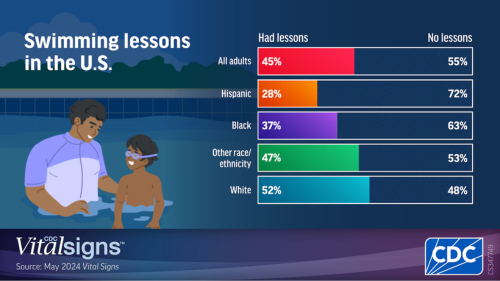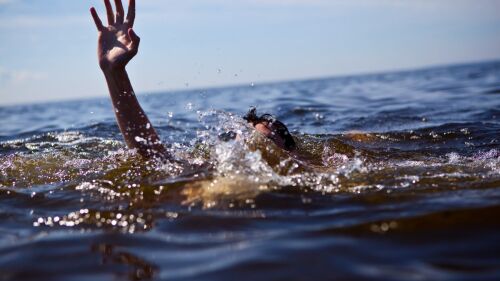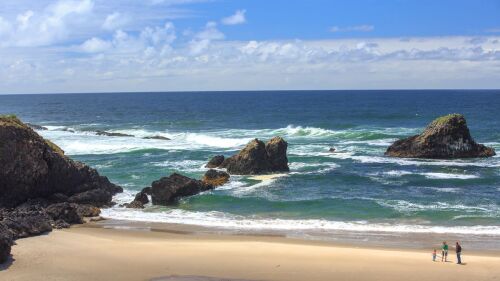By John Meyer
The Denver Post
DENVER — Six years after her son drowned while kayaking without a lifejacket in a reservoir on the Western Slope, Pamela Barrett returned to the lake in hopes that something good could come from her family’s tragedy. Perhaps, she told herself, lives will be saved.
On June 11, Barrett helped dedicate two new lifejacket loaner stations that Colorado Parks and Wildlife installed at Miramonte Reservoir where her son, Tanner Chesnut, died in May 2018 after his kayak flipped. The 21-year-old had loved hunting, fishing, hiking and spending time on that lake, 20 miles south of Norwood in a state wildlife area. It took 12 days to recover his body.
“I feel like if the lifejacket stations can help somebody — if it saves one person — it will be worth it,” Barrett said about the emotion of coming back to Miramonte. “I see people there without lifejackets and it just is really hard for me to see. I really struggle with that.”
Lifejacket loaner stations are places where visitors can borrow lifejackets if they don’t have one or forgot theirs. There are 40 of them at lakes and rivers maintained by CPW — including two each at Chatfield, Cherry Creek and Boyd Lake state parks. They’ve also emerged as a grassroots way for family members to honor loved ones who have drowned by trying to keep it from happening to someone else.
And it has been happening a lot in Colorado, even as officials have been pleading with kayakers, boaters and standup paddleboarders to wear lifejackets while on the water.
So far this year, 17 people have died in water-related incidents. Only two were wearing lifejackets, according to CPW, and both of those occurred in “swift water” incidents where other potentially lethal threats lurk besides drowning such as blunt force trauma.
That puts Colorado on pace to break its record of 35 drownings in 2022. Of those, 28 victims weren’t wearing lifejackets, CPW reported. The U.S. Coast Guard, which requires personal flotation devices on all watercraft including kayaks and paddleboards, says of the 564 water-related fatalities in the U.S. last year, 75% were due to drowning and 87% of those victims weren’t wearing lifejackets. Also, the Coast Guard said alcohol continued to be the leading contributing factor in fatal boating accidents in 2023, accounting for 17% of all fatalities.
Given the surge of drownings this spring, CPW seized a timely opportunity and took Denver Nuggets star Nikola Jokic to task last week for appearing in a video on social media that showed him whitewater rafting without a lifejacket on a river in Montenegro. They even offered to send him one that would fit his 6-foot-11 frame.
Nearly 80% of Colorado’s water-related fatalities involve paddlecraft — rafts, kayaks, standup paddleboards and canoes — according to Grant Brown, CPW’s boating safety program manager.
“People don’t think it can happen to them,” said Brown, whose job includes investigating fatal accidents as part of CPW’s Marine Evidence Recovery Team. “Because they can swim, they think they’re fine. I tell them you can swim when you are expecting to go for a swim, and you’re in a swimming pool where it’s 80 degrees, but not when you’re in a kayak and it turns upside down and you’re disoriented underwater in inherently cold water.
“Our cold water, I think, is the ultimate killer here. People cramp and panic. Cold water causes you to gasp, and it’s scary,” he added.
People don’t think they need them
The funding for loaner stations can come from a variety of sources — CPW, private individuals, nonprofits and grants – sometimes in collaboration.
There are four stations in the Arkansas Headwaters Recreation Area , which is managed by CPW. There are five in the Grand Lake area, placed there through the Christopher Mullinex Water Rescue Fund, which his parents founded after he drowned in Lake Granby in 2015.
At Sylvan Lake State Park, there are 38 lifejackets on loan near the entrance to the lake — a project jointly funded by Vail Health, the town of Eagle and CPW. Two can be found near the Canon City Whitewater Recreation Park within the Arkansas Headwaters Recreation Area. The city teamed up with CPW and a local nonprofit to install them.
Some, like the two at Chatfield Reservoir, are simply boxes with hinged tops. Others allow for jackets to be hung on hooks and secured behind a locked door. At some stations, park employees take borrowers’ contact info, while others operate on the honor system.
But the availability of lifejackets is only one issue. Also troubling to water safety advocates is the tendency of many watersports enthusiasts to think they don’t need to wear them. Several fatalities in recent years involved standup paddleboarders who either didn’t have lifejackets or tied them to their boards rather than wearing them. U.S. Coast Guard rules require all watercraft to have lifejackets aboard, and that includes paddleboards, but there is no requirement to wear them.
A look at some recent fatalities illustrates the problem.
Two involved standup paddleboards on lakes five miles apart on the Western Slope near Rifle last month. Both lakes have lifejacket loaner stations, and neither victim was wearing one. On May 12 at Rifle Gap State Park, a 26-year-old man fell into the water and drowned when “a strong gust of wind” knocked him and his girlfriend off their boards, according to the Garfield County coroner. Six days later, five miles to the east at Harvey Gap State Park, a 28-year-old man drowned after he and his companions were knocked off their boards by the wind. Neither victim wore a leash attaching them to their boards. In both cases, their bodies were recovered in more than 40 feet of water.
On June 1, rafters got into trouble in the Yarmony Rapids on the Upper Colorado southwest of Kremmling when their raft capsized. One died, one survived and a third remains missing. “Those gentlemen had jackets, they were just not wearing them,” Brown said, adding that their jackets were found attached to the raft, which was upside down.
Two kayakers without lifejackets were fishing at Chatfield Reservoir on March 30 when one capsized, Brown said. That kayaker swam over to his companion and that kayak capsized, so they attempted to swim to shore. One made it and one didn’t.
Even expert swimmers can drown
Even outstanding swimmers can drown in shallow water. That’s something one Centennial family knows only too well.
Fourteen years ago last week, Drennen O’Melia drowned in a country club swimming pool the day after he anchored two winning swim team relays and won an individual event. He was found in 3-4 feet of water with nearly 40 people at the pool. He was 12.
The oldest of three children, he was also an avid golfer. Three days before he drowned, he shot even par on a nine-hole par-3 course. His scorecard from that day still hangs on the refrigerator in the O’Melia home.
Drennen’s father, Bill, says no one knows why he drowned. Perhaps he was injured in seemingly harmless horseplay and no one noticed him go under. Two lifeguards were on duty, but Drennen’s body was found near a lifeguard chair that was unoccupied.
“It illustrates that even good swimmers can drown in shallow water with lots of people around,” O’Melia said.
O’Melia and his wife, Melissa, founded the Drennen’s Dreams Foundation in 2012 to promote drowning prevention and water safety. Bill speaks all over the country about those topics. Two weeks ago he spoke to 500 Los Angeles County lifeguards.
He also preaches the value of lifejacket loaner stations. Last year he built and installed one at Boyd Lake State Park in Larimer County, a magnet for water skiing and jet skis, and he is putting the finishing touches on another that will be installed soon at a lake in Windsor. He’s been involved in talks to get them installed at Lake Pueblo, Colorado’s busiest state park, where several drowning deaths have occurred in recent years.
After Drennen died, his parents went to grief counseling at Children’s Hospital and Judi’s House, founded by former Denver Broncos quarterback Brian Griese.
“You want somebody to wave the magic wand and make you stop feeling (terrible),” O’Melia said. “It just doesn’t happen that way. It’s a process. Those first two years, we were in a complete fog. I’d go to work, turn on my computer and I’d look for somebody to post new pictures of Drennen that I had never seen before. I was looking for answers non-stop.”
Over the years it got better, but the grief never goes away for good. “He was a smart, outgoing, athletic kid who had tons of friends,” his father said. “The world was his playground. He didn’t walk into the room, he bounced into the room, and the rest of us were there to entertain him.”
Turning a blind eye to safety Bob Pratt, executive director of the Great Lakes Surf Rescue Project, is a national authority on water safety who has made it his mission to prod paddleboard manufacturers to stop using models who are not wearing lifejackets in their advertising. He finds that “maddening” and irresponsible.
“Unfortunately the industry as a whole turns a blind eye to safety concerns,” said Pratt. “It’s a lost opportunity, it’s a failed opportunity. It’s gotten a little better. Maybe 30% or 40% of the ads (depict) proper safety equipment, but the vast majority do not.”
He often gets pushback when he urges manufacturers to be more responsible. “The general rule is, ‘You’re a safety Nazi. People have the right to make choices for themselves,’” Pratt said.
One common problem experts see over and over in standup paddleboard fatalities happens when victims have lifejackets attached to their boards, but when they fall into the water, the board floats away from them. And in windy conditions, boards can move a lot faster than victims can swim.
“If the wind comes up, you go into the water, you don’t have a leash on your paddleboard, you don’t have a lifejacket on and the board blows away from you, you’re in trouble,” O’Melia said. “And, try to put on a lifejacket while you’re in the water sometime. It’s not very easy to do.”
And it’s not just the paddleboarders. Brown recalls being on a rafting trip once with some BLM rangers on the Upper Colorado, near the scene of the recent tragedy there, when they saw a private rafting group get tossed into the water at the dangerous Needle Eye Rapids. They had lifejackets aboard but weren’t wearing them.
“We saw them all fall out,” Brown said. “We went to help them and they looked horrified when they got out. Then they put their jackets on. Especially on swiftwater, I really can’t wrap my head around not wearing a jacket.”
A culture shift is needed
One problem with lifejacket loaners: They need to be restocked because people tend to borrow them without returning them. Advocates have mixed emotions about that. They’d rather not have people walk away with them, but if that jacket gets multiple uses, at least it’s serving its purpose.
“If you’re going to have a station it needs to be kept up and maintained,” Brown said. “If people were just (borrowing) and then returning, that would be preferred. That’s the spirit of it. Grab one, be safe, wear it, enjoy it for the day. And, when you’re done, put it back where you got it so it’s there for someone else.”
Above all, the priority is getting people to wear lifejackets when they’re on the water. People used to ski without helmets. Widespread use of bike helmets is relatively new, for example.
“It’s going to take a paradigm shift in the way our culture views water safety,” O’Melia said. “When I was a kid, we all learned that if your clothes catch fire you stop, drop and roll. Smokey the Bear says, ‘Only you can prevent forest fires.’ I grew up in southern California, where we learned what to do if there was an earthquake. We don’t have that yet with drowning.
“If we can create that cultural paradigm shift in the way we approach drowning prevention and water safety,” he added, “that’s the key.”
©2024 MediaNews Group, Inc.
Visit at denverpost.com.
Distributed by Tribune Content Agency, LLC.
















